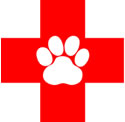Nonprofit formed by CVM residents partners with other animal welfare organizations to offer free spay and neuter clinics to help Puerto Rico’s recovery after Hurricane Maria.
The Storm
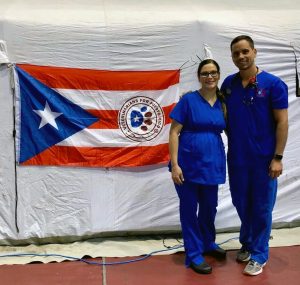
Aida Vientós-Plotts, DVM, and Willie Bidot, DVM, rock the colors of their birthplace, Puerto Rico. The former VHC residents formed a nonprofit to support the island after Hurricane Maria.
On Sept. 20, 2017, Puerto Rico experienced the worst natural disaster in its history. Hurricane Maria wreaked catastrophic destruction and created a humanitarian crisis when it struck the island, resulting in flooding, extensive infrastructure damage, and the worst electrical blackout in U.S. history, as every one of the island’s 3.4 million residents lost power. Maria, a 50-mile-wide hurricane with 150 mph winds, would prove to be the fifth-strongest storm ever to hit the United States and the deadliest storm of 2017’s hyperactive Atlantic hurricane season. Puerto Ri
co lost an estimated 3,000 human lives.
Maria made direct landfall, bisecting the island as it moved southeast to northwest. It would become the third-costliest storm in U.S. history; damage to Puerto Rico’s economy could total $150 billion.
The widespread ruination of housing and infrastructure shattered family life for many of the island’s residents. As U.S. citizens, Puerto Ricans can move freely to the mainland, and about 500,000 did so. The island, already burdened with a pet overpopulation problem that included about a million strays, now had more than 300,000 dogs and 1 million cats abandoned or homeless, trying to survive on its streets and beaches.
A Distant Response
More than 2,000 miles away, two transplanted island natives wondered and worried through their work as residents at MU’s College of Veterinary Medicine. Aida Vientós-Plotts, DVM, and Willie Bidot, DVM, may have felt apprehensive and anxious, but they were also determined to help.
The result was Veterinarians for Puerto Rico, a 501(c)(3) nonprofit organization dedicated to coping with the storm’s impact on the island’s animal population. The two veterinarians started out collecting money and supplies — including pet food, crates, medications, first-aid supplies and bottled water — to send to clinics and shelters on the island.
“We started in October 2017, and initially did a number of smaller events that year, by the end of 2017 we had vaccinated approximately 1,000 pets on the island free of charge,” Vientós-Plotts says.
Then, the nation’s leading animal advocacy organization came calling, and the newly born nonprofit was quickly swept into the big time.
Growing Up Fast
“In 2018, the Humane Society of the United States (HSUS) approached us,” Vientós-Plotts says. “They invited us to participate in this island-wide spay and neuter effort. Veterinarians for Puerto Rico is one of 26 animal welfare organizations that all came together to participate in Spayathon for Puerto Rico, four rounds of one-week-long, high-volume, high-quality spay and neuter clinics that offer services free of charge.”
Tara Loller, senior director of strategic campaigns and initiative for HSUS, framed the effort in historic terms.
“This is the first time such a broad coalition of organizations has come together, not only to intensively reduce the population of animals across an island, but also provide the resources and support necessary to continue that work long term,” Loller said. “We could not make this historic event happen without the generous participation of each and every coalition member.”
“We’re distinct from a lot of the other organizations that are playing a role in Spayathon because we’re the newest one — the baby of all these organizations,” Vientós-Plotts says. “Some of these other organizations have been going for years; they go on these trips and do these clinics all the time. This was our first experience doing anything like that, so we’re definitely learning as we go. But, we have prided ourselves on including a lot of Puerto Rican veterinarians who don’t live on the island, along with ones who do live on the island.”
All About Spayathon
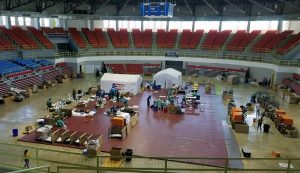
A coliseum converted to a surgery theater. “We try to make it look like an operating room, as much as we can, but you don’t have the things you have in a clinic,” says Vientós-Plotts
“The goal is to spay and neuter 30,000 animals over four rounds, which will be about a year’s time,” says Vientós-Plotts. “During the first six months of the Spayathon, 15,572 animals were spayed or neutered and vaccinated at no cost to owners. Rounds three and four are scheduled for February and May 2019, so we’re more than halfway there. Again, this is all completely free to pet owners.”
In addition to the spay/neuter focus, the 93 veterinarians volunteering with Vets for PR and the associated technicians and assistants have vaccinated 3,559 animals and distributed 44,000 pounds of food.
“A number of different companies donated food and products, so pets and owners go home with food, toys and other items when they are discharged,” Vientós-Plotts says.
“This initiative has been strongly supported by the government,” Vientós-Plotts says. “The first lady (Beatriz Rosselló, the wife of the governor), in particular, has taken a very special interest in this project. She comes and visits the sites, makes sure she brings greater awareness and encourages people to come and participate. It’s definitely helpful to have that kind of institutional support behind an initiative such as this one. All of the mayors we’ve worked with have been very supportive, too, providing us with resources we need while we’re at a particular location. One municipality got food for us while we were there a couple of days. That was so helpful, to not have to outsource that, and just have lunch delivered to where we were working so hard.”
A Labor of Love
“I would get there about 6:30 a.m. every day and we would leave somewhere between 7 and 9 p.m. Doing that while six months pregnant was … a lot of fun,” Vientós-Plotts says with a laugh. “It was definitely challenging, but it was very rewarding.
“I was overseeing the medical aspect of the event, while doing a lot of the discharging, giving instructions to owners, making sure everybody was OK and getting people out the door,” Vientós-Plotts recalls. “I got to hear all of the thanks, and occasionally a complaint. The doctors and technicians were working in the back, so they weren’t really getting all of those pet owner ‘thank-you‘ wishes that the people working out front were getting. I wanted to make sure we shared the kind words with our other volunteers, techs and doctors. I think it’s important for people to understand the impact they’re having. Sometimes, when you don’t see that, it’s really hard to keep going for another 14-hour or 18-hour day.
“We decided to put these giant Post-It notes along a wall where people were waiting to pick up their pets, so they could leave messages of thanks. Every afternoon and at the little debriefing we had every night, we’d bring all of the doctors and techs out front so they could see the thank-you notes that people had left. I think that was helpful for morale. I just finished volunteer-hours certificates for a lot of the students and they were averaging 80 to 100 hours a week. It was a lot of hard work.”
Making a Difference
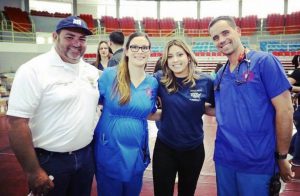
Mayor of Aguada Manuel Santiago, Vientós-Plotts, First Lady of Puerto Rico Beatriz Rosselló, Bidot. “The First Lady has taken a very special interest in this project. She visits the sites, makes sure she brings greater awareness, and encourages people to come and participate,” Vientós-Plotts says.
“We prided ourselves on including a lot of Puerto Rican veterinarians who don’t live on the island, along with ones who do live on the island,” Vientós-Plotts says. “This time around, we had three who came just for this: one from Florida, one from California, and one from New Jersey. We also had a South American veterinarian; she came for a week just to do this and run our recovery. It’s really nice to have people who don’t live on the island who want to give back, want to have the opportunity to do that, and this is a platform for them to do so. We also include a lot of the local veterinarians, where some of them close their clinic for the day to come and do surgeries, or help with physical exams or recovery. I think it is really nice to have that local support as well.
“Most of the groups outsource everything,” Vientós-Plotts says. “They bring their supplies, doctors and techs, and we are able to recruit lots of people that are on the island.
“There are a couple of tech programs, so those students have been able to come,” Vientós-Plotts reports. “We were able to incorporate one of the veterinary technician programs into the curriculum, so it’s one of their rotations, and they love it; they want to keep coming back. So, that’s 14 fourth-year veterinary technician students we have there. It’s really long days, but the experience they get is amazing. For the next round, we’re actually going to get to have the third-year students as well, so we’re really excited about getting to use that talent that we have on the island. It’s great for us and they’re getting a lot of valuable, hands-on practice. Depending on the day, we were doing 120-something procedures and, one day, we did 200 surgeries. So, the students learn a ton and they are very excited and proud to be part of the effort. It’s really nice to see that.
“We are more than happy to welcome any veterinarian who wants to come and be a part of this with us for a week, who wants to come do surgeries, or who wants to come and help with physical exams,” Vientós-Plotts says. “They don’t have to be Puerto Rican. If they are from Puerto Rico, it’s an opportunity to go back home and do something for their country and their community. But, other veterinarians who want to do something like this, that want to have an experience that is incredibly rewarding, it’s there for them. It’s tiring but it’s very rewarding to do something where you know you’re making a difference.”
We Rise by Lifting Others
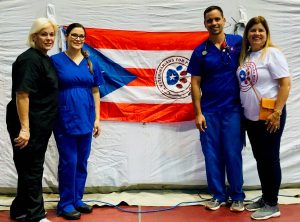
Vientós-Plotts, her mother, Yolanda Del Valle, Bidot, his mother, Frances Rodriguez. “This photo is near and dear to my heart,” Vientós-Plotts says. “Our moms are an integral part of our organization’s success because they were always there to help us and support us. Now, our moms have become friends and that has been really fun to see.”
“We knew this was an opportunity we could not allow to pass,” Vientós-Plotts recalls. “This has never happened in the world, having 26 organizations come and do thousands of surgeries in one week on one island. It’s a really big feat, but it’s not sustainable, not a thing we’re going to be able to do forever. But, I think it’s definitely a big start, with a big impact on the population, and hopefully it inspires other veterinarians to say, ‘If they can do all of that in an entire week, maybe I can take a weekend and go to this community and do it.’
“Willie and I started this with the idea that we were just going to help out for a little bit, and it snowballed into this giant nonprofit, and we are so incredibly proud of that,” Vientós-Plotts says. “Really, creating this organization has been like having a baby. We never really thought it was going to get to where it is now. We’re looking ahead, not just through Spayathon and the end of this year, but how we can continue to have an impact.
“We were able to buy a mobile clinic,” Vientós-Plotts reveals. “We’re outfitting it and hoping, once it is done, that we can provide veterinarians on the island an opportunity to say, ‘I want to do something for this particular community.’ Then, they can apply to our organization, request help from us, and we can provide them with all of the things they would need. We know we have veterinarians there who want to make a difference, but it’s hard to get to some of these areas, it’s expensive to have the instrumentation and the ways to do surgeries. So, we thought if we can provide all of the things that they need, that would be a way for us to prolong our impact on the island where, if they go and do 20 or 30 surgeries in one day, that’s 20 or 30 less animals that are going to reproduce. If we do that once a month, or once every other month on a consistent basis, it will really add up in the end.
“We want to let people know that, if they want to make a difference, they can,” Vientós-Plotts says. “All they have to do is look into something they care about. They don’t have to start their own nonprofit, but there are definitely volunteer opportunities out there. Anybody who is inspired to help can surely do so.
“Willie has finished his residency and is at the University of Florida. He’s a clinical assistant professor in the Animal Care Services department,” Vientós-Plotts says. “I’m doing my PhD here, and nearing my due date, yet we’ve still been able to continue on with this venture. It is possible to make a difference.”
The Long Road Ahead
To get to San Juan, the capital and most populous community in Puerto Rico, one flies over the Atlantic, and then over an ocean of blue tarps. More than a year later, those tarps issued by the U.S. Federal Emergency Management Agency still serve as roofs for thousands of homes. Estimates are that Hurricane Maria destroyed at least 70,000 houses and damaged another 300,000.
“The number of blue tarps you still see on homes that don’t have roofs is still impressive,” Vientós-Plotts says. “Initially, so much of the recovery effort was on putting in electrical posts and things like that. They were wooden posts, so it’s just kind of patched up here and there. But, they were concerned that another big storm would pretty much blow away a lot of the work they were doing. It was nice to have no hurricanes this year, just to buy a little bit more time to work on infrastructure.
“There’s still so much to be done,” Vientós-Plotts says. “Using just Spayathon as an example, when we thought about 30,000 as a goal, I initially wondered if we’d ever be able to do that many. Now, not only do I know we’ll be able to get there as a whole coalition, I feel that figure is not a high enough goal. The overpopulation is a big, big problem. Even we didn’t expect to see this incredible of a response from the public, to take advantage of the opportunity to take responsibility for their animals.
“Returning the island to anything like its previous condition is still a long way off, but the people of Puerto Rico very much have a fighting spirit,” Vientós-Plotts says. “They are proud people and feel like everybody came together to try to make things better.”
For more information, visit Veterinarians for Puerto Rico.

